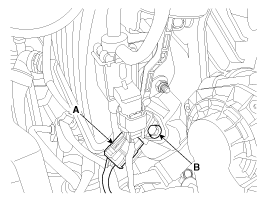Hyundai Tucson: Engine Control System / Intake Air Temperature Sensor (IATS) Repair procedures
| Inspection |
| 1. |
Turn the ignition switch OFF. |
| 2. |
Disconnect the IATS connector. |
| 3. |
Measure resistance between the IATS terminals 3 and 4. |
| 4. |
Check that the resistance is within the specification.
|
| Removal |
| 1. |
Turn the ignition switch OFF and disconnect the battery negative (-) cable. |
| 2. |
Disconnect the manifold absolute pressure sensor connector (A). |
| 3. |
Remove the installation bolt (B), and then remove the sensor from the surge tank.
|
| Installation |
|
|
| 1. |
Install in the reverse order of removal.
|
 Intake Air Temperature Sensor (IATS) Schematic Diagrams
Intake Air Temperature Sensor (IATS) Schematic Diagrams
Circuit Diagram
(M/T)
(A/T)
...
 Engine Coolant Temperature Sensor (ECTS) Description and Operation
Engine Coolant Temperature Sensor (ECTS) Description and Operation
Description
Engine Coolant Temperature Sensor (ECTS) is located in the
engine coolant passage of the cylinder head for detecting the engine
coolant temperature. The ECTS uses a thermistor that ...
Other information:
Hyundai Tucson (LM) 2010-2015 Owners Manual: Bluetooth® Wireless Technology AUDIO
What is Bluetooth® Wireless Technology?
Bluetooth® Wireless Technology allows devices to be connected
in a short distance, including hands-free devices, stereo headsets, wireless remote
controllers, etc. For more information, visit the Bluetooth® Wireless Technology
website at www.Bluetoot ...
Hyundai Tucson (LM) 2010-2015 Service Manual: Condenser Repair procedures
Inspection
1.
Check the condenser fins for clogging and damage. If clogged,
clean them with water, and blow them with compressed air. If bent,
gently bend them using a screwdriver or pliers.
2.
Check the condenser connections for leakage, and repair or replace it, if required.
Replace ...


